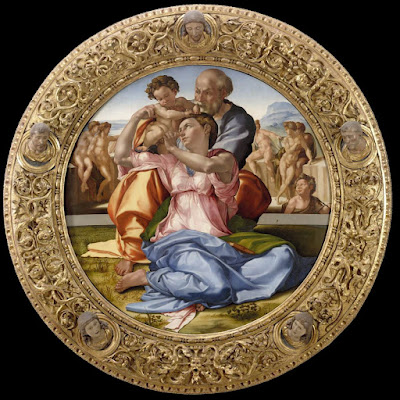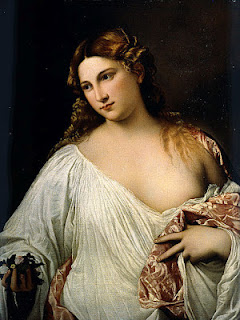Titian: The Conversion of Mary Magdalen.
This famous painting is usually called Sacred and Profane Love, a title attached to it only in 1694. Scholars have disputed the title and now we can see that the two women are Mary Magdalen as a courtesan, and as a penitent discarding her finery after her conversion. The fictive relief in the center represents, from right to left, St. Paul falling from his horse, Cain and Abel, and Adam and Eve. Oil on canvas. 1514. Borghese Gallery, Rome. 118 cm x 273 cm (46” x 110 “).
Giorgione: The Encounter of Jesus with the Rich Young Man.
This painting is usually called The Three Ages of Man from the obvious disparity in age of the three men, but the disparity, as well as the clothing, helps to identify Jesus on the right, wearing a green liturgical vestment, instructing the finely dressed rich young man in the center. St. Peter, typically depicted as a balding older man, is dressed in martyr’s red. He looks out and invites the viewer to participate. C. 1500-1501. Pitti Palace, Florence. 62 cm x 77.5 cm (24” x 30.5”).
Titian: Homage to Giorgione.
This small painting, usually known as The Pastoral Concert and variously attributed to either Giorgione or Titian, can now be seen as Titian’s Homage to Giorgione, his recently deceased mentor and friend. Giorgione is depicted in red finery in the center, but important details indicate that he has died: his face is in shadow; the absence of strings on his lute indicates he will play no more; and the dark sky in the background is ominous. Titian’s portrayal of himself as a young rustic recalls the biblical story of David and Jonathan. The two nude females are the muse Euterpe in different roles. On the left she pours Giorgione’s soul out like a libation, and in the center she hands her musical instrument to Titian. Oil on canvas. c. 1510. Louvre, Paris. 110 cm x 138 cm.
This painting is always called the Doni Tondo after Michelangelo’s patron, but scholars disagree about who is handing the infant Jesus to whom, and also about the nudes in the background. Now we can see that Mary elevates her Son as a priest elevates the Host at the consecration of the Mass. Joseph kneels as a communicant would do when receiving the Host. In the midground the young John the Baptist looks at the elevated Jesus and proclaims: “Behold the Lamb of God, who takes away the sins of the world.” The nudes in the background are the Nephilim or the Giants in the Earth those sinners who could only be destroyed by the Flood in the time of Noah. Uffizi gallery, Florence. c. 1507. Oil and tempera on panel. 120 cm diameter (47.5 ").
Titian: Mystic Marriage of St. Catherine.
Usually called The Madonna of the Rabbit because of the conspicuous white rabbit in the center, the subject of this painting is the mystical marriage of St. Catherine of Alexandria. Mary hands her Son to the saint as if she were giving the Eucharistic Host to a communicant. In her other hand she holds the white rabbit, which can now be seen as a symbol of the Eucharistic Host. St. Joseph, in rustic garb, sits off to the side stroking a black sheep that is symbolic of sacrifice. Oil on canvas. c. 1530. Louvre, Paris. 71 cm x 85 cm (28” x 33”).
This painting obviously depicts the Hebrew heroine Judith calmly standing over the decapitated Holofernes. However, her often discussed bared leg can now be recognized as a device used by Giorgione to indicate a woman in danger of sexual assault. Oil on canvas transferred from the original panel. c. 1504. Hermitage, St. Petersburg. 144 cm x 66.5 cm (57” x 26.2").
Giorgione: St. Sebastian
This painting is usually called The Boy with an Arrow, but the comparison with depictions of St. Sebastian by Raphael and others is obvious. Giorgione characteristically omits the halo but the young man’s angelic face as well as his red garment indicate the famous martyr. Oil on panel. c. 1505. Kunsthistorisches Museum, Vienna. 48 cm x 41.8 cm.
Giorgione: Conversion of Mary Magdalen.
The traditional labels, Laura, or Portrait of a Woman, do not fit. Scholars find no evidence for Petrarch’s lover, and no respectable woman would have sat for such a portrait. Details in this painting suggesting both a married woman, and a courtesan can only point to Mary Magdalen. Here, she sees the light and sheds her courtesan’s robe to become a bride of Christ. Oil on canvas mounted on panel. 1506. Kunsthstorisches Museum, Vienna. 41cm x 34 cm.
Titian: Conversion of Mary Magdalen.
Labelled Head of a Venetian Girl, this early painting by Titian resembles Giorgione’s Laura. Both can now be seen as Mary Magdalen in the process of removing her courtesan’s finery after seeing the light. Later Titian would paint many versions of Mary Magdalen, most of which featured the bared breast, disheveled clothing, and red hair. One even showed the saint with the same multi-colored shawl. Oil on panel transferred to canvas. c. 1509. Norton Simon Museum, Pasadena. 31.8 cm x 23.8 cm (12.5” x 9 .375 “).
Titian: Conversion of Mary Magdalen.
Scholars have questioned the traditional label of this painting as the Roman nymph Flora. Titian painted many images of Mary Magdalen in the process of discarding her courtesan’s garments after her conversion. Her partially bared breast, flowing red hair, and even the flowers in her hand that have sacred symbolism, all point to the great saint. Oil on canvas. c. 1517. Uffizi gallery, Florence. 79.7 cm x 63.5 cm (31.4” x 25”).
Giorgione: The Encounter with Robbers on the Flight into Egypt.
This mid-seventeenth centuty copy by David Teniers of a lost Giorgione painting was originally called the Finding of Paris after the legendary account of the discovery of the infant Trojan prince. Scholars attach great importance to this small painting because they think it shows Giorgione's early interest in the Trojan War cycle. However, every detail in the painting fits one of the legends about the biblical Flight into Egypt. The two men on the right are robbers and their cohorts can be seen sleeping in the mid-ground. Mary’s bared leg indicates her danger. The infant Jesus lies on a white cloth on the stony ground and the elderly Joseph sits off to the left. Oil on panel. 1656. Museum of Fine Art, Belgium. 21 cm x 30.5 cm. (8.2” x 12”).
Giorgione: The Three Magi behold the Star.
This painting was initially called Three Philosophers when seen in 1525 in the home of a Venetian patrician fifteen years after the death of Giorgione. Since that time scholars have not been able to agree on which philosophers are depicted. However, there is evidence that Giorgione has depicted the three Magi when they first behold the star of Bethlehem. The sun is setting in the background but the men are lit by another source of light. The colors of their garments are seen in other depictions of the Magi, and represent the gifts they will bring. Oil on canvas. c. 1506-1509. Kunsthistorisches Museum, Vienna. 123 cm x 144 cm (48” x 57”).
Palma Vecchio: The Meeting with John the Baptist on the Return from Egypt.
This large painting, currently in storage at the Philadelphia Museum of Art, is labeled “Allegory” for no good reason. In the center the infant Jesus embraces his older cousin, who according to legend also escaped Herod’s wrath. This very common scene depicts the acceptance by Jesus of his mission. Mary sits and watches on the left and Joseph stands guard on the right. The Lamb in the background helps to recall John’s words: “Behold the Lamb of God.” Oil on panel transferred to canvas. c. 1510-15. Philadelphia Museum of Art.
###

.jpg)






_-_Google_Art_Project.jpg)




